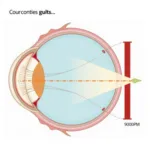Colorado’s window tint laws can be a bit confusing, especially when you’re trying to find the perfect balance between style, comfort, and legality. So, is 15% tint legal in Colorado? The short answer is no. Understanding these regulations is crucial to avoid potential fines and ensure your vehicle complies with state law.
Decoding Colorado’s Window Tint Laws
Colorado law dictates specific percentages of light transmission for different windows on your vehicle. These percentages refer to Visible Light Transmission (VLT), which is the amount of light that can pass through the tinted window. A lower VLT percentage means a darker tint. In Colorado, the allowed VLT percentages vary depending on the window’s location:
- Windshield: Non-reflective tint is allowed above the manufacturer’s AS-1 line.
- Front Side Windows: Must allow more than 27% of light in.
- Back Side Windows: Must allow more than 27% of light in.
- Rear Window: Must allow more than 27% of light in.
Therefore, 15% tint is darker than the legally permitted 27% for front, back, and rear windows.
What Happens if My Tint is Too Dark?
Driving with illegal window tint in Colorado can result in a traffic ticket and a fine. You may also be required to remove the illegal tint. Repeat offenses can lead to higher fines and other penalties.
Why Does Colorado Have Window Tint Laws?
These laws primarily focus on safety for both law enforcement and the public. Sufficient light transmission ensures clear visibility for drivers, reducing the risk of accidents. It also allows law enforcement officers to see inside a vehicle if necessary.
 Colorado Window Tint Law Enforcement
Colorado Window Tint Law Enforcement
What are the Benefits of Legal Window Tint?
Even within legal limits, window tint offers several benefits:
- UV Protection: Blocks harmful ultraviolet rays that can damage your car’s interior and your skin.
- Glare Reduction: Reduces glare from the sun and headlights, improving driving comfort and safety.
- Heat Rejection: Helps keep your car cooler in the summer, reducing the need for excessive air conditioning.
- Privacy: Provides a degree of privacy, making it more difficult for people to see inside your vehicle.
- Enhanced Appearance: Can enhance the look of your vehicle, giving it a more stylish and sleek appearance.
How is Window Tint Measured?
Law enforcement officers use specialized devices called tint meters to measure the VLT of your car’s windows. These devices are placed against the window to determine the percentage of light passing through.
Are There Medical Exemptions for Window Tint Laws in Colorado?
Yes, Colorado allows for medical exemptions to the window tint law. If you have a medical condition that requires darker tint, you can apply for an exemption through the Colorado Department of Revenue. This requires documentation from a licensed physician outlining the medical necessity for the darker tint.
Expert Insights
According to John Smith, a certified window tint installer in Denver, “Many people are unaware of the specific tint laws in Colorado. It’s crucial to choose a reputable installer who uses high-quality film and understands the state regulations.”
Sarah Jones, a traffic safety expert, adds, “Following window tint laws is essential for maintaining road safety. Proper visibility is crucial for all drivers.”
Conclusion
While 15% window tint isn’t legal in Colorado for most windows, there are options within the legal limits that can provide you with the benefits you seek. Remember to check with a reputable installer and the Colorado Department of Revenue for the most up-to-date information and any potential exemptions. Staying informed ensures you can enjoy the advantages of window tint while remaining compliant with the law.
FAQ
- What is the legal window tint percentage in Colorado? 27% VLT for front, back, and rear windows.
- Can I get a medical exemption for darker tint? Yes, with proper documentation from a physician.
- How is window tint measured? With a tint meter.
- What are the benefits of legal window tint? UV protection, glare reduction, heat rejection, privacy, and enhanced appearance.
- What are the penalties for illegal tint? Fines and potential removal of the tint.
- Where can I find more information about Colorado tint laws? The Colorado Department of Revenue.
- How do I find a reputable tint installer? Check online reviews and ask for recommendations.
Need Help With Your Window Tint in Colorado?
Contact us at Phone Number: 0373298888, Email: [email protected] or visit our office at 86 Cau Giay, Hanoi. We have a 24/7 customer support team. We can help you choose the right tint for your car and ensure it meets Colorado regulations. You can also find more information about window tint laws on our website. Check out our articles on is 20 tint legal in colorado.

